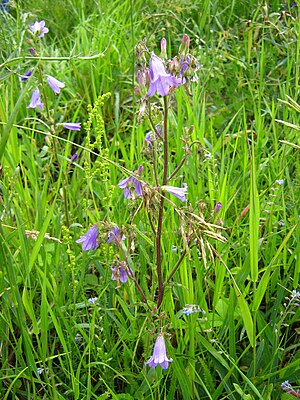Steppe Bellflower
| Steppe Bellflower | ||||||||||||
|---|---|---|---|---|---|---|---|---|---|---|---|---|

Steppe Bellflower ( Campanula sibirica ) |
||||||||||||
| Systematics | ||||||||||||
|
||||||||||||
| Scientific name | ||||||||||||
| Campanula sibirica | ||||||||||||
| L. |
The steppe bellflower ( Campanula sibirica ), also known as the Siberian bellflower , is a species of bellflower ( Campanula ) within the bellflower family (Campanulaceae). It is common in south-eastern Europe.
description
Vegetative characteristics
The steppe bellflower grows as a perennial herbaceous plant and reaches heights of 15 to 40, rarely up to 60 centimeters. The branched stem is hairy short. The leaves are arranged in a basal rosette and alternately distributed on the stem. The basal leaves are narrow-egg-shaped to narrow-lanceolate, gradually narrowing towards the base into the stalk, irregular and slightly serrated at the edge. The stem leaves are elongated-linear and wavy at the edge.
Generative characteristics
The flowering period extends from June to August. The flowers stand upright during anthesis and fade with nodding in an all-round, racemose inflorescence .
The hermaphroditic flowers are radial symmetry and five-fold with a double flower envelope . The five sepals are green. The calyx appendage is narrowly triangular to elongated with a length of 1.5 to 3 millimeters and protrudes from the ovary. The five dark blue-purple petals are fused like a bell, 15 to 20 millimeters long and (almost) bare inside on the edge.
The number of chromosomes is 2n = 34.
Locational conditions in Central Europe
The steppe bellflower needs calcareous or at least basic, loosely dry, often sandy or somewhat stony soils . It colonizes semi-arid grasslands , and occasionally roadsides. It is a species of character of the order Festucetalia valesiacae.
Systematics and distribution
The first publication of Campanula sibirica was made in 1753 by Carl Linnaeus in Species Plantarum , Volume 1, page 167. The specific epithet sibirica is from Siberia. The synonyms for Campanula sibirica L. are : Campanula charkeviczii Fed. , Campanula divergens Willd. Fish , Campanula Hohenackeri . & CAMey. , Campanula talievii Juz. , Campanula taurica Juz.
The main distribution of the steppe bellflower is in the steppes of south-east Europe and in south-east Europe (areas north of the Black Sea). It is also found in Turkey and western Siberia . It is seldom found in eastern Central Europe , in Mecklenburg-Western Pomerania and Brandenburg, at the southern foot of the Alps and on the eastern slope of the Vienna Woods , it occurs locally scattered.
Depending on the author, there are several subspecies (selection):
- Campanula sibirica subsp. divergens (Waldst. & Kit. ex Willd.) Nyman : It occurs in eastern Central Europe and in Southeastern Europe .
- Campanula sibirica subsp. elatior (Fomin) Fed. : It occurs from Ukraine to the Caucasus region.
- Campanula sibirica subsp. Hohenackeri (Fisch. & CAMey.) Damboldt : It occurs from northern and eastern Turkey to northwestern Iran .
- Campanula sibirica subsp. parviflora Ancev : It occurs in Bulgaria . It was first described in 2012.
- Campanula sibirica subsp. sibirica : It is widespread from the European mountains to the Uighur autonomous region of Xinjiang .
- Campanula sibirica subsp. taurica (Juz.) Fed. : It occurs in the Caucasus region and in the Crimea .
swell
literature
- Siegmund Seybold : The flora of Germany and the neighboring countries. A book for identifying all wild and frequently cultivated vascular plants . Founded by Otto Schmeil , Jost Fitschen . 95th completely revised and expanded edition. Quelle & Meyer, Wiebelsheim 2011, ISBN 978-3-494-01498-2 .
- Henning Haeupler, Thomas Muer: picture atlas of the fern and flowering plants of Germany . Published by the Federal Agency for Nature Conservation (= The fern and flowering plants of Germany . Volume 2 ). 2nd corrected and enlarged edition. Eugen Ulmer, Stuttgart (Hohenheim) 2007, ISBN 978-3-8001-4990-2 .
- Dietmar Aichele, Heinz-Werner Schwegler: The flowering plants of Central Europe . 2nd Edition. tape 4 : Nightshade plants to daisy plants . Franckh-Kosmos, Stuttgart 2000, ISBN 3-440-08048-X .
Individual evidence
- ↑ Campanula sibirica L., Siberian bellflower. In: FloraWeb.de.
- ↑ a b Erich Oberdorfer : Plant-sociological excursion flora for Germany and neighboring areas . With the collaboration of Angelika Schwabe and Theo Müller. 8th, heavily revised and expanded edition. Eugen Ulmer, Stuttgart (Hohenheim) 2001, ISBN 3-8001-3131-5 , pp. 891 .
- ↑ a b c d Campanula sibirica in the Germplasm Resources Information Network (GRIN), USDA , ARS , National Genetic Resources Program. National Germplasm Resources Laboratory, Beltsville, Maryland. Retrieved April 4, 2016.
- ↑ a b c d e f g Rafaël Govaerts (Ed.): Campanula - data sheet at World Checklist of Selected Plant Families of the Board of Trustees of the Royal Botanic Gardens, Kew. Last accessed on April 4, 2016.
Web links
- Campanula sibirica subsp. sibirica L., Siberian bellflower (subspecies). In: FloraWeb.de.
- Steppe Bellflower . In: BiolFlor, the database of biological-ecological characteristics of the flora of Germany.
- Thomas Meyer: Bellflower data sheet with identification key and photos at Flora-de: Flora von Deutschland (old name of the website: Flowers in Swabia ).
- Data sheet with description based on Hermann Wagner (1882) and links to photos.
- Günther Blaich: data sheet with photos.


